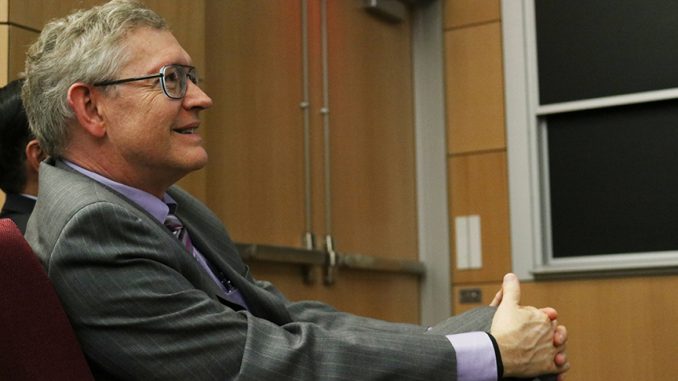
Nobel Laureate William E. Moerner has felt like he’s under pressure since winning the highest award in science two years ago.
“People seeing new research projects we undertake have extremely high expectations,” he told The Temple News. “Some people attach a certain aura to Nobel laureates, but we’re still normal people.”
“As my wife says, I pull on my pants one leg at a time,” he added.
The Provost Lecture Series hosted Moerner’s talk on his work Thursday afternoon in the Science and Education Research Center to a full house and then some—many attendees had to stand or sit on the floor.
Moerner, currently a professor of chemistry at Stanford University, received the Nobel Prize in Chemistry in 2014 for developing a technique to see smaller molecular structures and their processes by using fluorescent light.
Moerner said the Nobel Prize has afforded him new opportunities, particularly for speaking engagements. In 2014, he gave 54 talks around the world and said they were “a great opportunity to talk about and explain science to the broader world.”
“There’s a little bit more freedom to explore some areas I didn’t want to explore before,” Moerner said. “I’m very excited and motivated by questions that haven’t been answered yet. … There’s a great feeling of pushing back the frontiers.”
Moerner said he’s been interested in science since he was in high school. He enjoyed taking things like cars and TV sets apart with his father and seeing how they worked, as well as conducting chemistry experiments in his backyard clubhouse.
His first exposure to experimental science was as an undergraduate at Washington University in St. Louis, where he earned degrees in physics, electrical engineering and mathematics. He said most of the early steps in his career, however, occurred when he was studying physics in graduate school at Cornell University.
In graduate school, Moerner used infrared to cause molecules embedded in crystals to vibrate, which was the first optical experiment of its kind.
Moerner said he wants to encourage young people to follow their passions and seek to find out how the world works.
“There’s a lack of appreciation for the scientific method,” he said. “Science is powerful enough to predict that if we send a probe to Pluto, eight years later it lands in the exact place we sent it. … If we know something is extremely probable, we can act on it.”
Outside of teaching, giving talks and working with his team of graduate students at Stanford—dubbed the Guacamoles—Moerner said he enjoys amateur radio work with emergency communications in California and singing classical music in large choral groups.
Moerner’s influence even extended into pop culture when his name was featured in an episode of “The Simpsons,” in which the characters had a Nobel Prize betting pool.
“What’s the next best thing to being picked for a Nobel Prize?” he asked the audience. “Being picked by Milhouse on ‘The Simpsons!’”
Moerner showed the audience a photo of the back of his Nobel Medal for Physics and Chemistry, which depicts nature and science as two women, with science uncovering the face of nature.
“It illustrates one of the reasons we’re here, to lift the veil of nature,” he said. “Science works based on what you’re doing at the time, what you know and how you can push back the frontiers. … You have to know what’s to be expected and then be ready to throw it away when something changes.”
Provost Hai-Lung Dai, who is a Laura H. Carnell professor of chemistry, said he and Moerner come from similar fields.
“[Moerner is] a great example of how our science is developing today,” he added. “Today’s science is very interdisciplinary so he’s using his expertise in physics, math and engineering, solving problems for chemistry, engineering and medicine.”
David DiCarlo, a visiting researcher who is earning his master’s degree in biology from Italy, said he has never had the opportunity to meet a scientist of Moerner’s caliber.
“I think he can mix knowledge and passion … it’s the most important thing,” he said. “When you work with passion, you have your results.”
“When we study science, we learn new things about the world,” Moerner said. “There’s a great power and excitement to exploring science. We need young people to understand complex things because the world is becoming more technologically complex. … We need to have this need instilled in our hearts.”
Lian Parsons can be reached at lian.parsons@temple.edu or on Twitter @Lian_Parsons.


Be the first to comment